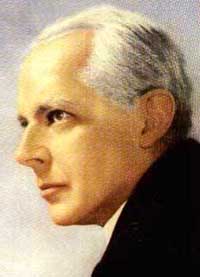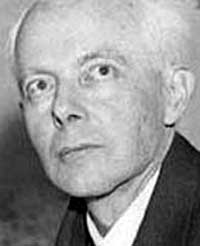Copyright Michael D. Robbins 2006
Astro-Rayological
Interpretation & Charts
Quotes
Biography
Images and Physiognomic Interpretation
I cannot conceive of music that expresses absolutely nothing.
Competitions are for horses, not artists.
BIOGRAPHY
Béla Bartók (March 25, 1881 - September 26, 1945) was a composer, pianist and collector of East European folk music. Bartók was one of the founders of the field of ethnomusicology, the study of folk music and the music of non-Western cultures. Bartók grew up in the Greater Hungary of the Austro-Hungarian Empire which was partitioned by the Treaty of Trianon after World War I. His birthplace, Nagyszentmiklós (Great St Nicholas), became Sânnicolau Mare, Romania. After his father died in 1888, Béla's mother, Paula, took her family to live in Vinogradiv (Hungarian: Nagyszöllös, now in Ukraine), and then to Prešporok (Hungarian: Pozsony, now Bratislava) in her native Slovakia. When Czechoslovakia was created in 1918 Béla and his mother found themselves on opposite sides of a border.He later studied piano under István Thoman and composition under János Koessler at the Royal Academy of Music in Budapest. There he met Zoltán Kodály and together they collected folk music from the region. This was to have a major impact on his style. Previously, Bartók's idea of Hungarian folk music was derived from the gypsy melodies to be found in the works of Franz Liszt, and in 1903 Bartók had written a large orchestral work, Kossuth, which honored Lajos Kossuth, hero of the Hungarian revolution of 1848, incorporated such gypsy melodies.
Upon discovering Magyar peasant folk song, not the gypsie music of Liszt, which Bartók regarded as true Hungarian folk music, he began to incorporate folk songs into his own compositions and write original folk-like tunes, as well as frequently using folksy rhythmic figures.
It was the music of Richard Strauss, which he met at the Budapest premiere of Also sprach Zarathustra in 1902, that had most influence.
This new style emerged over the next few years. Bartók was building a career for himself as a pianist, when in 1907 he landed a job as piano professor at the Royal Academy. This allowed him to stay in Hungary rather than having to tour Europe as a pianist, and also allowed him to collect more folk songs, notably in Transylvania. Meanwhile his music was beginning to be influenced by this activity and by the music of Claude Debussy that Kodály had brought back from Paris. His large scale orchestral works were still in the manner of Johannes Brahms or Richard Strauss, but he wrote a number of small piano pieces which show his growing interest in folk music. Probably the first piece to show clear signs of this new interest is the String Quartet No. 1 (1908), which has several folk-like elements in it.
In 1909 Bartók married Márta Ziegler . Their son, Béla Jr., was born in 1910.
In 1911, Bartók wrote what was to be his only opera, Bluebeard's Castle, dedicated to his wife, Márta. He entered it for a prize awarded by the Hungarian Fine Arts Commission, but they said it was unplayable, and rejected it out of hand. The opera remained unperformed until 1918, when Bartók was pressured by the government to remove the name of the librettist, Béla Balázs, from the program on account of his political views. Bartók refused, and eventually withdrew the work. For the rest of his life, Bartók did not feel greatly attached to the government or institutions of Hungary, although his love affair with its folk music continued.
After his disappointment over the Fine Arts Commission prize, Bartók wrote very little for two or three years, preferring to concentrate on folk music collecting and arranging (in Central Europe, the Balkans and Turkey). However, the outbreak of World War I forced him to stop these expeditions, and he returned to composing, writing the ballet The Wooden Prince in 1914-16 and the String Quartet No. 2 in 1915-17. It was The Wooden Prince which gave him some degree of international fame.
Bartók subsequently worked on another ballet, The Miraculous Mandarin, influenced by Igor Stravinsky, Arnold Schoenberg, as well as Richard Strauss, following this up with his two violin sonatas which are harmonically and structurally some of the most complex pieces he wrote. He wrote his third and fourth string quartets, regarded as some of the finest string quartets ever written, in 1927-28, after which his harmonic language began to become simpler. The String Quartet No. 5 (1934) is somewhat more traditional from this point of view. Bartók wrote his sixth and last string quartet in 1939.
The Miraculous Mandarin was started in 1918, but not performed until 1926 because of its sexual content: a sordid modern story of prostitution, robbery, and murder.
Bartók divorced Márta in 1923, and married a piano student, Ditta Pásztory . His second son, Péter, was born in 1924. For Péter's music lessons Bartók began composing a six-volume collection of graded piano pieces, Mikrokosmos ,which is popular to piano students today. It was to be the last piece he wrote in Europe.
In 1940, after the outbreak of World War II,and the European political situation worsened, Bartók was increasingly tempted to flee Hungary.
Bartók was strongly opposed to the Nazis. After they came into power in Germany, he refused to concertize there and switched away from his German publisher. And his liberal views (as mentioned with the ballet compositions, Bluebeard's Castle and The Miraculous Mandarin ) caused him a great deal of trouble from right-wingers in Hungary.
Having first sent his manuscripts out of the country, Bartók reluctantly moved to the USA with Ditta Pásztory. Péter Bartók joined them in 1942 and later enlisted in the United States Navy. Béla Bartók, Jr. remained in Hungary.
Bartók did not feel comfortable in the US, and found it very difficult to write. As well, he wasn't well known in America and there was little interest in his music. He and his wife Ditta would give concerts; and for a while, they had a research grant to work on a collection of Yugoslav folksongs, but their finances were precarious, as was Bartók's health.
His last work might well have been the String Quartet No. 6, were it not for Serge Koussevitsky commissioning him to write the Concerto for Orchestra (Bartók's most popular work, which was to ease his financial burdens). He was also commissioned by Yehudi Menuhin to write Sonata for Solo Violin. This seemed to reawaken his interest in composing, and he went on to write his Piano Concerto No. 3, an airy and almost neo-classical work, and begin work on his Viola Concerto.
Béla Bartók died in New York in the United States from leukemia. He left the viola concerto unfinished at his death, which was later completed by his pupil, Tibor Serly.
He was interred in the Ferncliff Cemetery in Hartsdale, New York, but after the fall of Hungarian communism in 1988, his remains were transferred to Budapest, Hungary for a state funeral on July 7, 1988 with interment in Budapest's Farkasreti Cemetery.


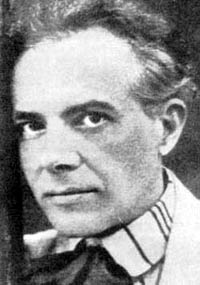
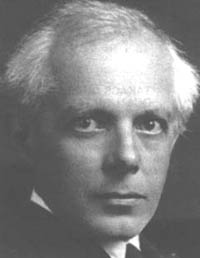
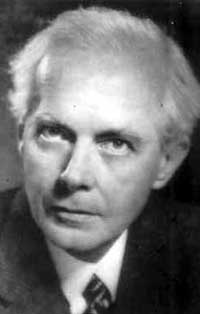 I
I